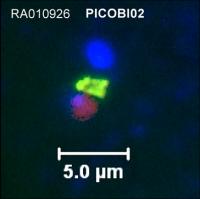
The picture shows a phycobiliphyta cell in fluorescence microscope. The cell nucleus is colored in blue, the cytoplasma in green. The red fluorescence comes from a plastide with phycobiliproteins, pigments that usually occur in red algae, cyanobacteria and cryptophyceae. The cell measures 2x5 µm (1µm = 1/1000 millimeter).
Credit: Fabrice Not/Station Biologique de Roscoff An international group of researchers has succeeded in identifying a previously unknown group of algae. As currently reported in the scientific journal Science, the newly discovered algae are found among the smallest members of photosynthetic plankton - the picoplankton ('Picobiliphytes: A marine picoplanktonic algal group with unknown affinities to other Eukaroytes" Science, Vol. 316'). On account of the minute size of the organisms (no more than a few thousandth of a millimetre) and the appearance of phycobili-proteins, researchers have termed the new group Picobiliphyta.
Approximately 50 percent of global photosynthesis is conducted in the world's oceans where it is dominated by microscopic algae, the so-called phytoplankton. Scientists estimate that up to 90 percent of phytoplanktonic species are currently unidentified. In the present study, scientists used molecular techniques to investigate the smallest members of the plankton, the picoplankton. Because picoplankton algae are so extremely small, they are almost impossible to study by means of microscopy.
Researchers investigated gene sequences of the 18S gene, common to all cells. The identity of new organisms can be deduced from a comparison of familiar and unfamiliar gene sequences. "The gene sequences found in these algae could not be associated with any previously known group of organisms", explain Dr Klaus Valentin and Dr. Linda Medlin, co-authors of the study and molecularbiologists at the Alfred Wegener Institute in Bremerhaven. The algae in this study were found in plankton samples originating from various regions of the North Atlantic and the Mediterranean. The scientists have discovered a group of organisms which, despite being completely new to science, have a wide distribution. "This is a good indication for how much there is still to discover in the oceans, especially using molecular tools", says Valentin. Apart from the unfamiliar gene sequences, the researchers also extracted phycobili-proteins from the algae. In red algae, for example, these proteins occur as colour pigments. However, in the newly discovered algal group, the phycobili-proteins are found at the sites for photosynthesis, i.e. in the plastids. This location of pigment proteins represents a novelty in that it has not been reported for any other algal species. Hence, it provides a clear indication that the researchers are dealing with a previously unidentified species of algae. Referring to their small size and the presence of phycobili proteins, the researchers named the new group Picobiliphytes.
Source : Alfred Wegener Institute for Polar and Marine Research
 Print Article
Print Article Mail to a Friend
Mail to a Friend
